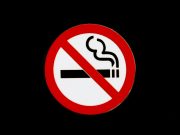Other inaccurate claims included that the tested products were found to contain “extremely dangerous” chemicals, yet the report failed to mention the amounts found of the alleged harmful chemicals. The only level mentioned in the report was that of nicotine, which science tells us, is not any more harmful than caffeine.
Mendelsohn explained that there are small doses of toxins in many things we consume but that they are harmful in small doses, hence context is crucial. “This report provides no useful information and simply seeks to alarm and mislead the public and promote the Queensland anti-vaping agenda,” he said. “The Health Minister’s claim that these unmeasured chemicals are “extremely dangerous” is unscientific and totally unjustified.”
Unscientific facts shared by “trustworthy” sources
Similarly, last year, the NSW government has launched a $300,000 “educational” campaign to address the issue of teen vaping. Acting NSW Chief Health Officer Marianne Gale said the “centre piece” of the campaign is the Get the Facts – Vaping Toolkit, which is pitched at teachers, parents and students aged 14 to 17, and contains evidence-based resources and educational material. Sadly, the opposite is true, the alleged facts were once again blown out of proportion and not based on science.
The spread of such misinformation is especially tragic when research has indicated that the number of smokers in NSW has dropped to record low levels thanks to an increase in vaping. In fact, data from the NSW Population Health Survey, has indicated that 11% of people aged between 16 to 24 have reported being current vapers. This figure has more than doubled since 2020.
Misinformation and baseless claims
In 2020, Melbourne’s City council had proposed banning vaping in the city’s 11 no-smoking areas. Lord mayor Sally Capp, had said that the ban would align the city with the rest of the state, where sadly e-cigs are subjected to the same regulations as cigarettes.
Quit Victoria boss Dr Sarah White inaccurately stated that breathing in other people’s aerosol, just like inhaling secondhand smoke can increase the risk of diseases. “Second-hand smoke or aerosol from e-cigarettes can also trigger asthma attacks and make some people feel ill,” White said.
While last August, Professor Steve Robson, President of the Australian Medical Association (AMA) has written to Federal Health Minister Hon. Mark Butler MP, urging him to set in place stricter vape restrictions.
Figures from countries where vaping products have been regulated instead of banned, indicate that smoking rates keep dropping, as are vaping rates. On the other hand, Robson’s letter to the Minister for Health and Aged Care, not only insisted that the risks of vaping products outweigh the benefits, but also inaccurately reiterated that they act as a gateway to smoking. Robson also claimed that vaping can cause seizures, nicotine poisoning and e-cigarette associated lung injuries.
Australia’s stance has stalled smoking cessation rates
Meanwhile, a 2022 study published in BMJ Open had confirmed that Australia’s harsh and outdated stance on vaping, has stalled the country’s smoking cessation rates. Titled, “Impact of vaping introduction on cigarette smoking in six jurisdictions with varied regulatory approaches to vaping: an interrupted time series analysis,” the study analyzed smoking rates and cigarette consumption in 6 jurisdictions with different regulatory environments for vaping: Alberta, Ontario, Quebec and British Columbia (in Canada), UK and Australia.
Of these, Australia has the harshest vape regulations and subsequently the lowest vaping rates. However it also has one of the lowest rates of progress with regards to declining smoking rates. Discussing these findings, Mendelsohn reiterated that in Canada and the UK, smoking consumption and smoking rates in young adults started declining faster once vapes arrived on the scene.
“Australia has the harshest vaping regulations in the western world based on misguided concerns that vaping could lead young people who would otherwise not take up smoking to smoke. However this is perversely preventing adults from accessing a life-saving alternative and leading to more smoking-related deaths and illnesses,” he explained.













